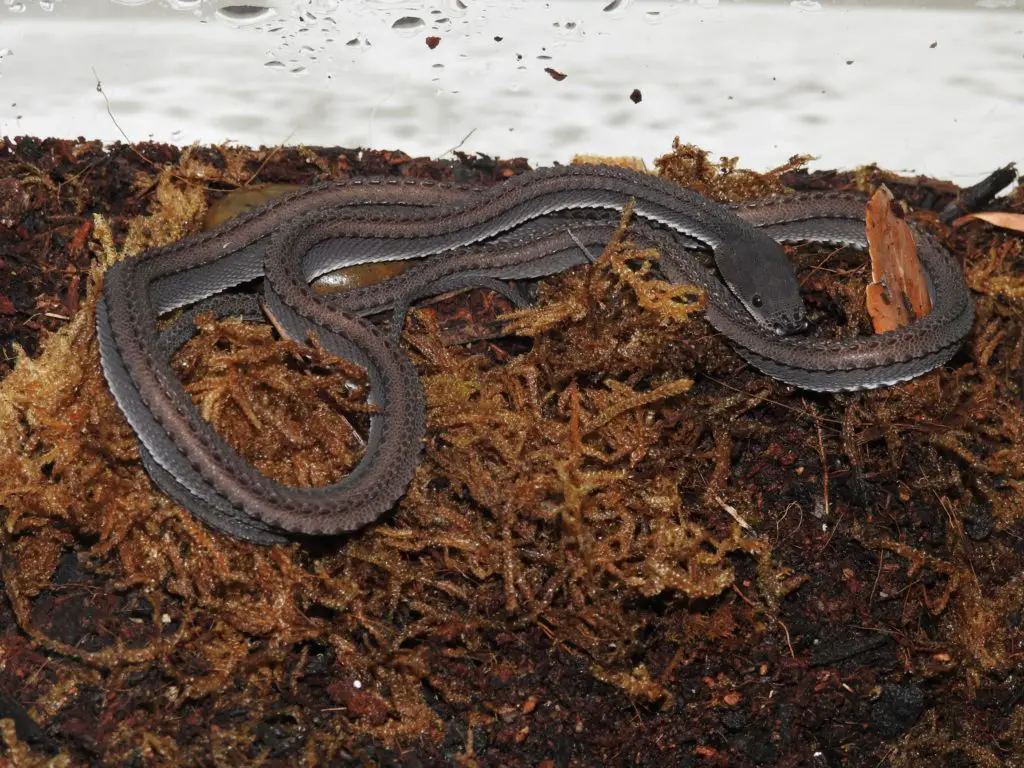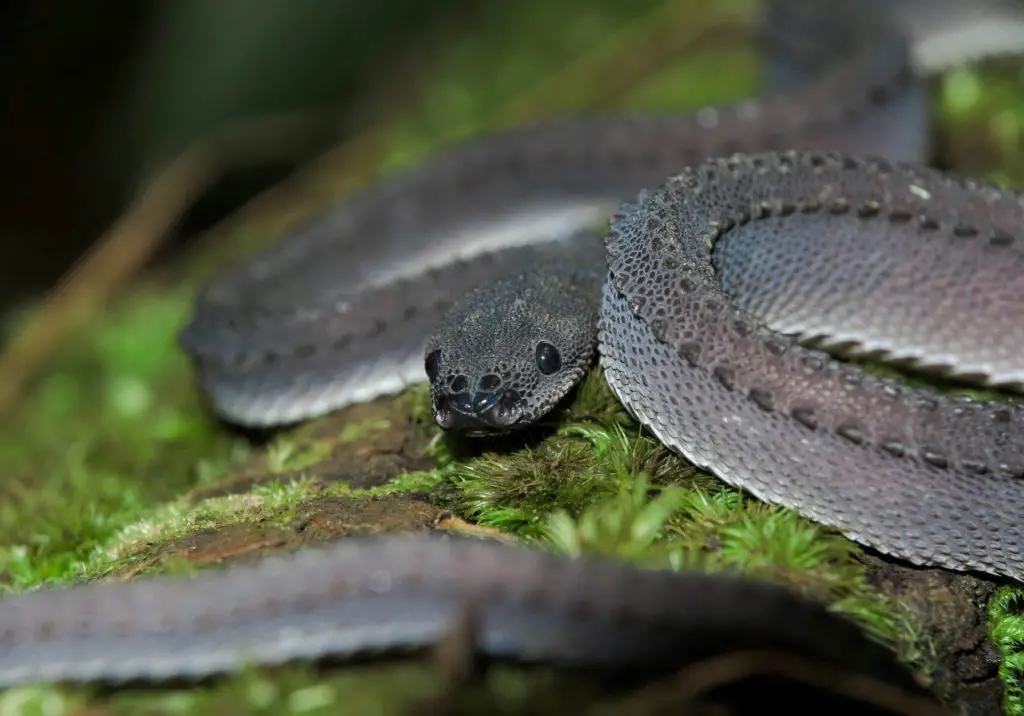You may have heard it called the Javan Mud Snake, Rough-backed Leaf Litter Snake or Javan Tubercle Snake. Whatever you call it, (Xenodermus javanicus) is one of the most unique snake species on the planet. Let’s checkout some Dragon Snake facts…
Last updated on February 1st, 2023 at 09:42 am
Dragon Snake Facts
A small, semi-fossorial yet often aquatic hunter, the Dragon Snake species is placed in the monotypic genus Xenodermus. Xenodermus itself is a member of the Xenodermidae family. There are other genera in the Xenodermidae family, but we still don’t know how the family as a whole is related to others.
A monotypic genus only has one representative – meaning that this snake has no close relatives. As far as we know, Dragon Snake classification goes like this:
- Class: Reptilia
- Order: Squamata
- Suborder: Serpentes
- Family: Xenodermidae
- Genus: Xenodermus
- Species: Xenodermus Javanicus
The Xenodermidae family Belongs to the Colubroidea superfamily, which contains most snake families. Many of your favourite snakes, including Colubrids, Elapids, and Viperids are in this group. Though these snakes are all familiar, the relationship between them and the Xenodermidae is still poorly understood.
Xenodermidae may be more closely related to the File Snake superfamily, the Acrochordoidea, than it is to other Colubroidea families. It will be many years before taxonomists make a final decision on this one, but this is my feeling.
As far as appearance goes, the Dragon Snake’s defining characteristic is its scalation, which is unlike that of other snakes.
Indeed, some scales around the rostrum (nose) are large and specialised, as in Colubrids, whereas those on the rest of the head and body are tiny and tuberculate like those of the File Snakes (Acrochordidae).
Most striking, however are the three rows of large, raised scales along the back. These are of course what gave rise to the common name of “Dragon Snake”.

Dragon Snake scales
There’s a lot of speculation as to the purpose of these raised rows of scales (asides from looking cool). As a herpetologist, I can confidently tell you that I don’t know what they’re for!
What I can tell you is that along with these scales they have unusually long tails which may suggest a lot of time spent in water. Many aquatic and semi-aquatic animals use a tail as an anchor when hunting in the water, a prime example being the Tentacled Snake (Erpeton tentaculatum), another south-east Asian fish hunter.
It is very possible that the tail of the Dragon Snake serves a similar purpose, helping them wedge between rocks and resist the current, or gain leverage when manhandling prey. This is what got me thinking about their three rows of raised dorsal scales…
The peculiar scales could simply help them anchor themselves during hunting, as their tail probably does. Then again, these snakes burrow and hide during the day, to the extent that they are incredibly hard to find, even in areas where they are abundant.
If this daytime hiding takes place in abandoned burrows or holes between rocks, ridges of raised scales would be a great way to wedge themselves in and prevent a predator from pulling them out. Could their scales be a daytime, defensive anchor?
Obviously, this is pure speculation! It would however explain their convergence with the scales of the Borneo Earless Monitor (Lanthanotus borneensis), which occupies similar habitat and occupies burrows during the day.

Where do Dragon Snakes live?
The Dragon Snake occurs from the Malay peninsula southwards to Borneo, Sumatra, and Java – a region sometimes referred to as the Sunda Islands. According to some sources, it is more abundant in the south of its range, though admittedly this could be down to reporting bias.
In the wild it prefers damp areas with loose substrate and abundant water. This is typical in much of the Sunda Island ecoregion. In Borneo, for example, forest habitat is criss-crossed with extremely numerous streams and small rivers.
Adjacent to these the forest leaf litter can pile up and be quite thick in areas. This roughage provides perfect hiding and burrowing opportunities for Dragon Snakes and other species such as Reed Snakes (Calamaria spp.)

Such habitat also has a specific temperature – all the time! After surveying a year’s worth of data from eastern Borneo, I found this to be 24-25C (75-77F) during the day and 21-22C (70-72F) at night, with almost no seasonal variation. This is true even when temperatures are at 28-32C (82-90F) just a few miles away!
Rainforests create their own, cooler climate. This is why rice grows well there near them – too much heat kills the crop. It’s no coincidence that Dragon Snakes often live in rice fields and are also reported to be very vulnerable to fluctuations in temperature.
This has been one of the main issues when trying to establish them in captivity. They simply do better in a temperature-controlled room!

Behaviour
Dragon Snakes are a nocturnal, shy species that has a dislike of bright light and stress.
Being highly secretive, they burrow into substrate or hide wherever they can during the day. It is this behaviour that makes them hard to observe either in the wild or as a captive. They may in fact be more common than we think throughout much of their range.
When it comes to self-defence, these snakes often forgo biting and simply stiffen up like a stick.
Though it sounds silly, this type of behaviour is probably a confusion tactic. It may give the snake enough time to escape while a predator decides what it is, whether it’s dead, or simply what on earth is happening?
What do Dragon Snakes eat?
As you’d expect for a shy little part-time burrower/part-time stream forager, the Dragon Snake seems to be a pretty puny predator. As far as we can tell, it favours small fish, frogs and tadpoles.
Overall, it’s unlikely it ever takes down big prey items, or those that put up much of a fight. In fact, it seems to be about as capable as our harmless Slow Worm here in the UK.
Captive specimens have shown a preference for hunting tadpoles and small fish in their water bowls, reinforcing the idea that they naturally hunt in the water most of the time.

Dragon Snake Breeding
Being oviparous, the females are bigger than males, and have slightly thinner, shorter (though still very long) tails.
In males, the hemipenal bulge can be visible, and alongside their thicker tails, this is the best method for sexing them.
As far as we know, females lay around 4 eggs, though one clutch of 5 was recorded in captivity.
Like any rainforest/equatorial species, the eggs need a lower incubation temperature than many other reptiles and are probably very vulnerable to temperature fluctuations.
Dragon Snake Care: can you have one as a pet?
We had to get to this question at some point, didn’t we? And though I find Dragon Snakes fascinating from a scientific point of view, I won’t be buying one anytime soon.
There are not many species I’m nervous about keeping – but I would think twice about getting one of these. I’ll be waiting for a hardy, captive-bred population to be available.
Establishing this snake in captivity is a tough process because they are vulnerable to stress. Most imports you will see available are already stressed and parasitized. Generally, this means they could literally only last a few weeks after you buy them. What a waste!
The truth is a lot of patience, veterinary assistance, money, and luck may be needed to get just one to stay alive in captivity.
Some people are making great strides with their husbandry, and captive breeding will happen soon. Realistically, however, it could still be a long time before captive-bred hatchlings become widely available.
Moreover, they hate handling and light. It’s safe to say they will never be as rewarding to most people as Ball Pythons or Milk Snakes, for example.

Dragon Snakes for Sale
Despite their obviously poor suitability as a pet, you’ll still see Dragon Snakes for sale at pretty high prices. Don’t let someone rip you off!
Buying an import of this species is a bad idea, unless you have several years of experience establishing imported reptiles with specialised husbandry requirements.
The truth is that buying wild caught animals such as these hurts you and them. It encourages importers to harm wild populations and hurts the reputation of our hobby.
The most common issues that imported snakes arrive with are:
- internal parasites
- external parasites
- known or unknown infectious disease that could wipe out the rest of your collection
- long-term dehydration
- long-term stress
Conclusion
The Dragon Snake is a fascinating snake with a unique appearance. It is most definitely one of nature’s weirdos, and that’s what we like about it!
Form a taxonomic point of view, this species’ relationship with other snake genera is still not completely clear. Fortunately, it appears to be thriving in the wild so there is yet time to gain a greater understanding. Future studies may show the Dragon Snake has a lot to teach us about the evolution of the Colubroidea superfamily. Who knows?
What we know for sure is that this snake is a valuable species to study in terms of understanding how environment and niche affect scalation. If you’re interested in herpetology, reading about the Dragon Snake and reflecting on the possible purposes behind its unique scalation is time well spent.
Buying a Dragon Snake on the other hand, may be a terrible idea – until they are consistently bred in captivity. Sadly, it’s not going to make it into the mainstream of the hobby any time soon!
FAQ relating to Dragon Snake facts
Are dragon snakes aggressive?
Dragon Snakes are not aggressive at all. In fact, their only known defense mechanism is to become as stiff as a board when you pick them up – if they can be bothered, that is. They don’t bite or even struggle either. Being nocturnal and semi-aquatic, these snakes rely on not be noticed by predators rather than fighting back against them.
Do dragon snakes lay eggs?
Like Pythons, Cobras, and Corn Snakes, Dragon Snakes are oviparous, meaning that they lay eggs. For some reason they only lay 3 or 4 at the most, though. Why this may be is still unclear. It may be because they have a slow metabolism and find the energetic cost of egg production very taxing.
Can dragon snakes swim?
Dragon Snakes can swim – just like every other species of snake discovered so far. They mostly forage in shallow, slow-moving streams and rice paddies, which allows them to swim at a calm pace. Though they are comfortable in the water, they are not capable of powerful swimming like Water Snakes (Nerodia spp.) or Garter Snakes (Thamnophis spp.).

